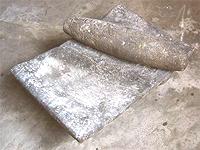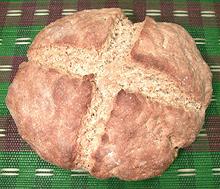
SAFARI
Users
- General & History
- Regional Breads
- Africa
- Europe - land of 10,000 breads.
- Greece to Punjab - Where bread probably originated.
- India
- Asia - East & Southeast
- Health & Nutrition
General & History
 The first baked breads made from ground flour were baked more than
30,000 years ago, when people learned that a stone sliding over a flat
rock could efficiently grind dried grains very fine. This would have
helped make gruels with better texture, but also allowed making more
edible flat breads.
The first baked breads made from ground flour were baked more than
30,000 years ago, when people learned that a stone sliding over a flat
rock could efficiently grind dried grains very fine. This would have
helped make gruels with better texture, but also allowed making more
edible flat breads.
Bread did not become a staple at that time, because wild grains did not lend themselves to easy harvesting - but, about 10,000 years ago, wheat, barley and other grains were "domesticated". This was done by selective breeding to produce seed heads that did not "shatter", but held their seeds until all the grains were ripe, and then released them fairly easily on the threshing floor.
Leavened breads no doubt also originated in the depths of pre-history. After all, yeasts are everywhere, and surely someone was called away and left some dough for a few hours, probably under leaves so it wouldn't dry out. The first solid archaeological evidence we have is from ancient Egypt. Unleavened flat breads, lightly leavened breads, and fully leavened light loaves are all made today.
Bread did not really take off in the Far East. Wheat, the best grain for bread, was despised by the Chinese because whole grain wheat took a very long time to cook and didn't work well for porridge and similar uses. The Chinese hadn't invented making bulgur as was made in the Eastern Mediterranean region, and they had no way to grind such a hard grain.
Later, the Chinese imported real grinding mills from the Roman Empire and wheat became the darling of the Imperial Court, but the flour was used for dumpling wrappers and the like, not bread. The Chinese didn't have the hard, high gluten wheat that makes good bread.
Grains:
Hard, high gluten wheat makes the best bread. Nearly all leavened breads have plenty of hard wheat flour mixed in. Those with the least are Scandinavian dark rye breads, but the dough must be well soured to make a loaf that rises at all well. Other European rye breads are made with light rye flour and are mostly wheat. High gluten wheat flour has traditionally been quite expensive, so the common people have often diluted it with rye, oats, barley, potatoes, and other less expensive ingredients (most of which are not less expensive here in North America). Note that "glutenous rice" and "glutenous millet" contain no gluten.Yeast:
Yeast is what makes most breads rise (soda breads use a chemical reaction between baking soda and acid). The yeasts eat sugars in the grain (or added sugars) and fart out carbon dioxide gas. the gas becomes entangled in the wheat gluten forming bubbles. Without the gluten the gas escapes. While wild yeasts are everywhere and will, given time, infect dough and cause it to rise, we haven't time for that, and the results can be erratic. We use either commercial yeasts, or a sourdough starter with a well developed yeast colony. In the earliest times, bread was leavened with the foam from brewing beer, or other beer byproducts. In ancient Egypt the brewers were also the bakers, making this easy.Health and Nutrition
Proteins:
"You can't live on bread alone" is true at a very basic level. Grains do not have a complete set of the amino acids (proteins) humans must get from their diet because they cannot make them internally. Fortunately, legumes (beans) are also deficient in this way, but oppositely, so grains and beans compliment each other to provide humans with a complete set of "essential" amino acids. Note however, that a purely vegetable diet doesn't provide certain other essentials, particularly vitamin B12, essential for nerve and brain health.Gluten:
Some people, perhaps even as high as one in 105 persons in the United States, suffer a genetic autoimmune condition called "celiac disease". For them, avoiding gluten proteins is a very serious matter as even tiny amounts can cause digestive distress and/or other symptoms. If they don't very carefully avoid gluten, pain, declining health and an early death results.Wheat makes the best leavened bread because it is the grain highest in gluten. Grains low in gluten aren't suitable for light breads. Yeast fermentation progresses, but the bubbles of carbon dioxide escape without gluten to trap them.
For the majority, gluten, in the quantities you should be consuming it, does not not seem to be a problem. This has not stopped a number of very vocal "nutrition experts" from declaring that everyone should avoid gluten entirely. This has cause many people to ascribe every discomfort to "gluten", resulting in tremendous growth for production of "gluten free" processed foods, sold at premium prices.
Note that some people have "wheat allergy" conditions that are not associated with gluten. They may be able to eat other gluten containing grains without problems.
Carbohydrates:
Grains and baked goods contain considerable amounts of carbohydrates. In particular, refined carbs are digested too quickly and may result in problems with type II diabetes. Of course, sugars of any kind are far worse than carbs from even refined grains.Many self appointed "nutrition experts" are preaching a very low or no carbohydrate diet, including the Paleo Diet and others. This is strictly an elitist attitude, impossible for most of the world's population. For most, the choice is grains or starvation. Modern medical opinion holds that starvation is measurably more injurious to health than carbs.
Whole Grains:
Some promote whole grains as essential for health, while others claim they are loaded with toxins and anti-nutrients. One very prominent anti-carb "natural health" practitioner found he didn't do well without some carbs in his diet. He eats only a little white potato and white rice, and won't touch whole grains on a bet.Of course plants do have toxins and anti-nutrients for their own protection, but most humans have lived on whole grains for the last 10,000 years, and it does not seem to have resulted in population decline. On the other hand, a little white rice and bread aren't so bad if you have a diverse and adequate diet.
A recent study of Asians who live primarily on rice found that the incidence of type II diabetes was slightly higher in those who ate white rice compared to those who eat brown rice. This doesn't sound like a big problem for most Americans. How could we even measure the difference buried under all that sugar consumption?
One caution: commercial "whole grain" products are often not actually made from whole grains, but of white flour with the byproducts of milling added back in. This may result in pointy stuff that possibly can damage the digestive tract.
In summary, diets of the "hunter-gatherer sort are possible for only a tiny percentage of the population - those who can afford the expensive pills and potions sold by many of the "natural health" practitioners. Why should they worry about anyone else?
While the hunter-gatherer sort of diet may offer superior nutrition, when there is plenty of food, geneticists believe that at one point in our ancestral hunter-gatherer days, the human population had dropped to between 2000 and 5000 individuals in the whole world, due to food shortage.
See also our Medical Disclaimer.


